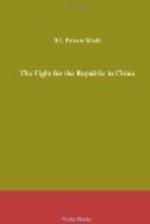His responsibility, however, was very great; for the keynote of all this scheme, according to Dr. Goodnow[12], was “centralization of power,” a parrot-like phrase which has deluded better men than ever came to China and which—save as a method necessary during a state of war—should have no place in modern politics. But it was precisely this which appealed to Yuan Shih-kai. Although as President he was ex officio Commander-in-Chief of the Army and Navy, he now turned this office into a direct and special organization installed within the precincts of the Imperial City. The flags of this new dictatorship constantly floated over his palace, whilst scores of officers were appointed to scores of departments which were directly concerned with centralizing the control of every armed man in the country in the master’s hands. Meanwhile in order to placate provincial commanders, a “Palace of Generals,” was created in Peking to which were brought all men it was held desirable to emasculate. Here, drawing ample salaries, they could sit in idleness the livelong day, discussing the battles they had never fought and intriguing against one another, two occupations in which the product of the older school of men in China excels. Provincial levies which had any military virtue, were gradually disbanded, though many of the rascals and rapscallions, who were open menaces to good government were left with arms in their hands so as to be an argument in favour of drastic police-rule. Thus it is significant of the underlying falseness and weakness of the dictator’s character that he never dared to touch the troops of the reprobate General Chang Hsun, who had made trouble for years, and who had nearly embroiled China in war with Japan during the so-called Second Revolution (July-August, 1913) by massacring some Japanese civilians in the streets of Nanking when the city was recaptured. So far from disbanding his men, Chang Hsun managed constantly to increase his army of 30,000 men on the plea that the post of Inspector-General of the Yangtsze Valley, which had been given to him as a reward for refusing to throw in his lot with the Southern rebels, demanded larger forces. Yuan Shih-kai, although half afraid of him, found him at various periods useful as a counterweight to other generals in the provinces; in any case he was not the man to risk anything by attempting to crush him. As he was planted with his men astride of the strategically important Pukow railway, it was always possible to order him at a moment’s notice into the Yangtsze Valley which was thus constantly under the menace of fire and sword.




